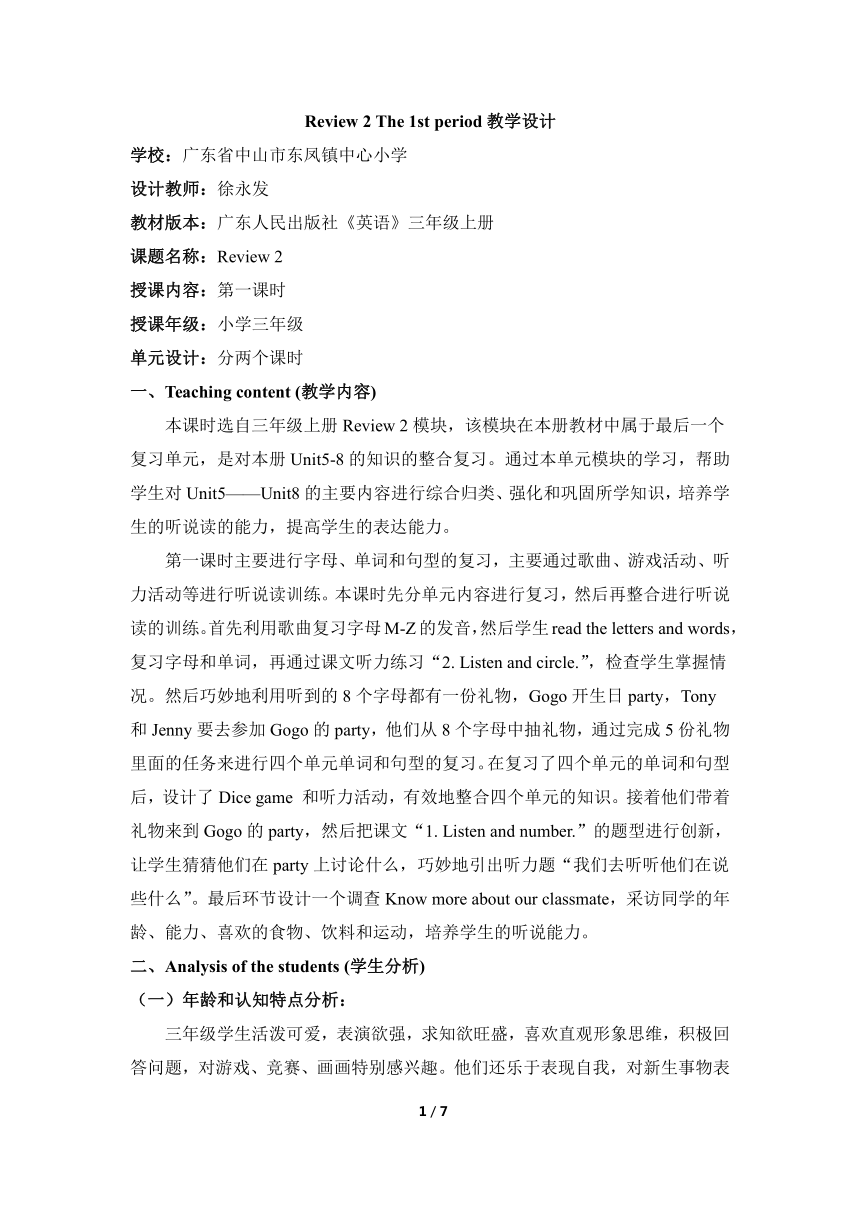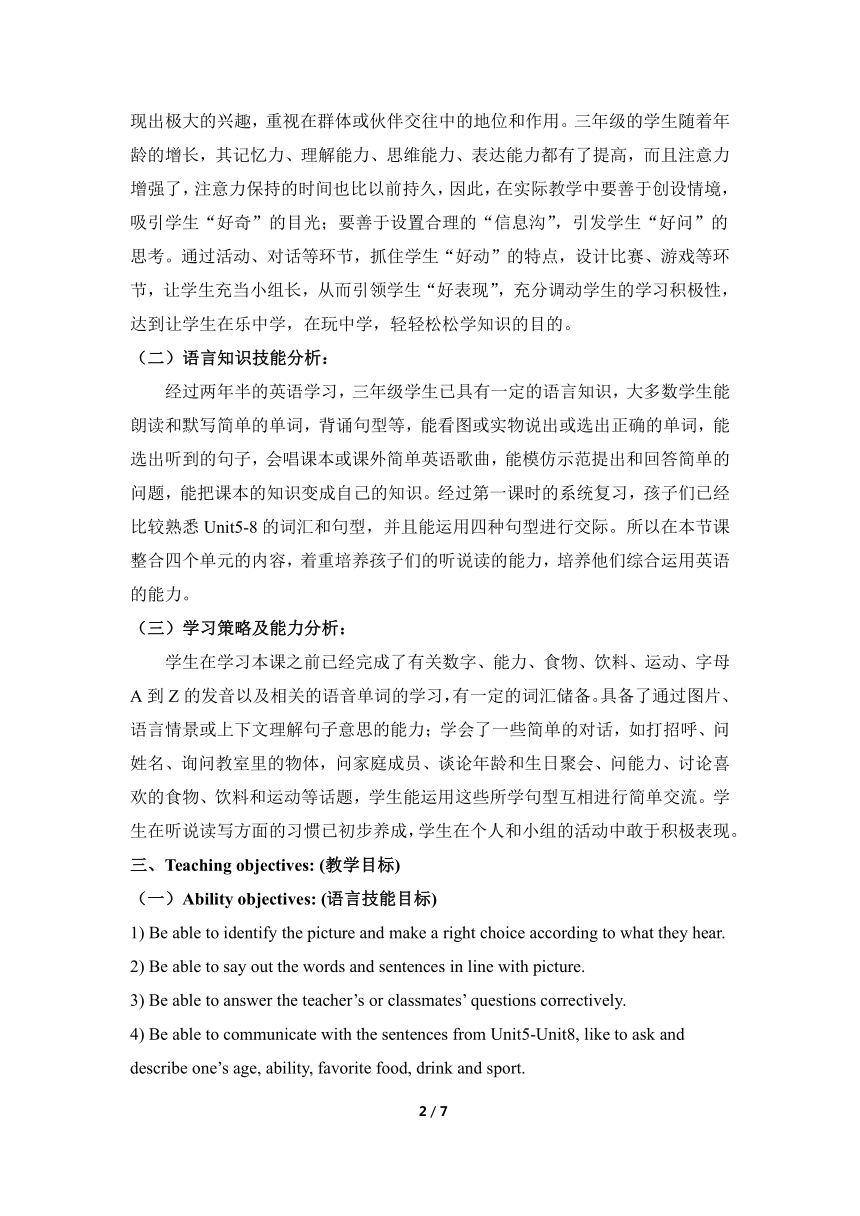广东版(先锋、开心)开心学英语三年级上册 Review 2 第一课时教案
文档属性
| 名称 | 广东版(先锋、开心)开心学英语三年级上册 Review 2 第一课时教案 |

|
|
| 格式 | zip | ||
| 文件大小 | 190.7KB | ||
| 资源类型 | 教案 | ||
| 版本资源 | 广东版 | ||
| 科目 | 英语 | ||
| 更新时间 | 2019-12-07 17:50:48 | ||
图片预览



文档简介
Review 2 The 1st period教学设计
学校:广东省中山市东凤镇中心小学
设计教师:徐永发
教材版本:广东人民出版社《英语》三年级上册
课题名称:Review 2
授课内容:第一课时
授课年级:小学三年级
单元设计:分两个课时
一、Teaching content (教学内容)
本课时选自三年级上册Review 2模块,该模块在本册教材中属于最后一个复习单元,是对本册Unit5-8的知识的整合复习。通过本单元模块的学习,帮助学生对Unit5——Unit8的主要内容进行综合归类、强化和巩固所学知识,培养学生的听说读的能力,提高学生的表达能力。
第一课时主要进行字母、单词和句型的复习,主要通过歌曲、游戏活动、听力活动等进行听说读训练。本课时先分单元内容进行复习,然后再整合进行听说读的训练。首先利用歌曲复习字母M-Z的发音,然后学生read the letters and words,复习字母和单词,再通过课文听力练习“2. Listen and circle.”,检查学生掌握情况。然后巧妙地利用听到的8个字母都有一份礼物,Gogo开生日party,Tony和Jenny要去参加Gogo的party,他们从8个字母中抽礼物,通过完成5份礼物里面的任务来进行四个单元单词和句型的复习。在复习了四个单元的单词和句型后,设计了Dice game 和听力活动,有效地整合四个单元的知识。接着他们带着礼物来到Gogo的party,然后把课文“1. Listen and number.”的题型进行创新,让学生猜猜他们在party上讨论什么,巧妙地引出听力题“我们去听听他们在说些什么”。最后环节设计一个调查Know more about our classmate,采访同学的年龄、能力、喜欢的食物、饮料和运动,培养学生的听说能力。
二、Analysis of the students (学生分析)
(一)年龄和认知特点分析:
三年级学生活泼可爱,表演欲强,求知欲旺盛,喜欢直观形象思维,积极回答问题,对游戏、竞赛、画画特别感兴趣。他们还乐于表现自我,对新生事物表现出极大的兴趣,重视在群体或伙伴交往中的地位和作用。三年级的学生随着年龄的增长,其记忆力、理解能力、思维能力、表达能力都有了提高,而且注意力增强了,注意力保持的时间也比以前持久,因此,在实际教学中要善于创设情境,吸引学生“好奇”的目光;要善于设置合理的“信息沟”,引发学生“好问”的思考。通过活动、对话等环节,抓住学生“好动”的特点,设计比赛、游戏等环节,让学生充当小组长,从而引领学生“好表现”,充分调动学生的学习积极性,达到让学生在乐中学,在玩中学,轻轻松松学知识的目的。
(二)语言知识技能分析:
经过两年半的英语学习,三年级学生已具有一定的语言知识,大多数学生能朗读和默写简单的单词,背诵句型等,能看图或实物说出或选出正确的单词,能选出听到的句子,会唱课本或课外简单英语歌曲,能模仿示范提出和回答简单的问题,能把课本的知识变成自己的知识。经过第一课时的系统复习,孩子们已经比较熟悉Unit5-8的词汇和句型,并且能运用四种句型进行交际。所以在本节课整合四个单元的内容,着重培养孩子们的听说读的能力,培养他们综合运用英语的能力。
(三)学习策略及能力分析:
学生在学习本课之前已经完成了有关数字、能力、食物、饮料、运动、字母A到Z的发音以及相关的语音单词的学习,有一定的词汇储备。具备了通过图片、语言情景或上下文理解句子意思的能力;学会了一些简单的对话,如打招呼、问姓名、询问教室里的物体,问家庭成员、谈论年龄和生日聚会、问能力、讨论喜欢的食物、饮料和运动等话题,学生能运用这些所学句型互相进行简单交流。学生在听说读写方面的习惯已初步养成,学生在个人和小组的活动中敢于积极表现。
三、Teaching objectives: (教学目标)
(一)Ability objectives: (语言技能目标)
1) Be able to identify the picture and make a right choice according to what they hear.
2) Be able to say out the words and sentences in line with picture.
3) Be able to answer the teacher’s or classmates’ questions correctively.
4) Be able to communicate with the sentences from Unit5-Unit8, like to ask and describe one’s age, ability, favorite food, drink and sport.
(二)Knowledge objectives: (语言知识目标)
1. Be able to listen, read and say the Alphabets from M- Z, and the alphabet words.
2. Be able to listen, read and say the words from Unit5 to Unit8.
3. Be able to listen, read and speak the sentences from Unit5 to Unit8:How old are you? I’m … Can you …? Yes, I can. / No, I can’t. What do you like? I like … Do you like …? Yes, I do. / No, I don’t.
(三)Moral objectives: (情感态度目标)
Develop students' comprehensive abilities of using language, improve the ability of cooperation and communication, arouse their awareness of healthy food and proper exercise.
(四)Learning-strategy objectives: (学习策略目标)
1. Let students practice learning content actively through a variety of activities and practices.
2. Let students learn to cooperate and complete the study tasks together through the cooperative learning and competition.
(五)Culture objectives: (文化意识目标)
Know that soccer and football are different in American English. And in western society, people usually don’t ask each other’s age, as they take age as one’s privacy.
四、Teaching key points: (教学重点)
(一)Be able to listen, read and say the words from Unit5 to Unit8.
(二)Be able to use the sentences to communicate.
(三)Be able to listen, read and say the Alphabets from M-Z, and the alphabet words.
五、Teaching difficult points: (教学难点)
(一)Use the sentence patterns correctly.
(二)Be able to answer the questions correctively “Do you …?” and “Can you …?”
六、Instructional strategies:(教学策略)
(一)Teaching methods:
Task-based approach, communicative approach, Audio-lingual approach, cooperative learning and games teaching method.
(二)Teaching aids:
CAI, PPT, exercise paper and dices
七、Teaching map (教学流程图)
/
/
八、Teaching procedure: (教学过程)
Step1: Warming up and revision.
1. Sing the alphabet song
2. Read the words about alphabet.
3. Do a listening exercise: Listen and circle the letters
【设计意图】和学生进行简短的问候后,带领学生一边做动作一边唱歌,接着复习字母M- Z,再辅以练习巩固提高,这既由浅入深地复习了字母知识,也激发了学生继续学习的兴趣。
Step2: Presentation
The eight letters have eight presents. It’s Gogo’s birthday party. Tony and Jenny want to join Gogo’s party. They want some presents from the eight letters. They have to turn around the cards, finish the tasks and then get the presents. 1. Present 3: Review Unit 8 1) Look and say: Guess the words 2) Do the actions and guess.
Do you like …? Yes, I do.
No, I don’t.
【设计意图】故事导入,情景设计,词句结合复习,由浅到深,让学生在师生、生生交流中知识得到提高。
2. Present 8: Review Unit 6
1) Game: What’s missing?
2) Ask and answer.
Can you …? Yes, I can.
No, I can’t. But I can …
【设计意图】设计游戏,让学生在趣味中复习了词句,在合作交流中操练了句型。
3. Present 6: Review Unit7
1) Magic eyes: Read the words.
2) Look and match: Put the words on the right baskets.
3) Look and say. What do you like? I like … I like … and …
【设计意图】变换形式,复习单词后进一步巩固,再通过师生问答,生生互动来操练句型。
4. Present 4: Review Unit 5
1) Bomb game
When the word and the picture is right, please read the words. When they are not right, please stand up and say “Bomb”.
2) Ask and answer How old are you? I’m … How old is she / he? She’s / He’s …
【设计意图】采用学生喜欢的游戏来复习单词,活跃课堂气氛,再联系实际,运用句型进行交流。
Step3: Drills
5. Present 5: Practice the words and sentences.
1) Listen and circle.
2) Dice game.
/
【设计意图】在系统复习了几个单元的词句后,综合各单元知识,进行听力练习,然后通过Dcie game的游戏,有效地进行单词和句子的复习,培养学生的知识运用能力。
Step4: Extension
They go to Gogo’s party.
1. Talk: What are they talking at the party?
2. Do a listening exercise.
【设计意图】呼应故事发展,培养学生联想发散思维。
3. Make a survey: Know more about our classmates Use the sentences to ask the partner, and tick.
How old are you?
What do you like?
Can you …?
Do you like …?
【设计意图】联系实际,拓展学生综合运用知识的能力,检验他们对知识的灵活运用。
Step5: Sum-up
Sum up the sentences and the group match.
Step6: Homework
1. Finish Exercise four: Make a survey on your father or mother.
2. Finish part 5 on book P59.
【设计意图】有针对性地布置作业,培养学生说和写的能力,延伸课堂内容,让学生继续保持学习兴趣,并在生活中运用所学知识。
九、Teaching test arrangement: (教学检测安排) (课堂上4处,课后1处)
(一)Listen and circle the letters;
(二)Listen and circle;
(三)Listen and number;
(四)Make a survey;
(五)Finish part 5 on book P59.
十、Blackboard writing: (板书设计)
Review 2 (Period1)
Do you like …? Yes, I do.
No, I don’t.
Can you …? Yes, I can.
No, I can’t.
What do you like? I like …
How old are you? I’m …
学校:广东省中山市东凤镇中心小学
设计教师:徐永发
教材版本:广东人民出版社《英语》三年级上册
课题名称:Review 2
授课内容:第一课时
授课年级:小学三年级
单元设计:分两个课时
一、Teaching content (教学内容)
本课时选自三年级上册Review 2模块,该模块在本册教材中属于最后一个复习单元,是对本册Unit5-8的知识的整合复习。通过本单元模块的学习,帮助学生对Unit5——Unit8的主要内容进行综合归类、强化和巩固所学知识,培养学生的听说读的能力,提高学生的表达能力。
第一课时主要进行字母、单词和句型的复习,主要通过歌曲、游戏活动、听力活动等进行听说读训练。本课时先分单元内容进行复习,然后再整合进行听说读的训练。首先利用歌曲复习字母M-Z的发音,然后学生read the letters and words,复习字母和单词,再通过课文听力练习“2. Listen and circle.”,检查学生掌握情况。然后巧妙地利用听到的8个字母都有一份礼物,Gogo开生日party,Tony和Jenny要去参加Gogo的party,他们从8个字母中抽礼物,通过完成5份礼物里面的任务来进行四个单元单词和句型的复习。在复习了四个单元的单词和句型后,设计了Dice game 和听力活动,有效地整合四个单元的知识。接着他们带着礼物来到Gogo的party,然后把课文“1. Listen and number.”的题型进行创新,让学生猜猜他们在party上讨论什么,巧妙地引出听力题“我们去听听他们在说些什么”。最后环节设计一个调查Know more about our classmate,采访同学的年龄、能力、喜欢的食物、饮料和运动,培养学生的听说能力。
二、Analysis of the students (学生分析)
(一)年龄和认知特点分析:
三年级学生活泼可爱,表演欲强,求知欲旺盛,喜欢直观形象思维,积极回答问题,对游戏、竞赛、画画特别感兴趣。他们还乐于表现自我,对新生事物表现出极大的兴趣,重视在群体或伙伴交往中的地位和作用。三年级的学生随着年龄的增长,其记忆力、理解能力、思维能力、表达能力都有了提高,而且注意力增强了,注意力保持的时间也比以前持久,因此,在实际教学中要善于创设情境,吸引学生“好奇”的目光;要善于设置合理的“信息沟”,引发学生“好问”的思考。通过活动、对话等环节,抓住学生“好动”的特点,设计比赛、游戏等环节,让学生充当小组长,从而引领学生“好表现”,充分调动学生的学习积极性,达到让学生在乐中学,在玩中学,轻轻松松学知识的目的。
(二)语言知识技能分析:
经过两年半的英语学习,三年级学生已具有一定的语言知识,大多数学生能朗读和默写简单的单词,背诵句型等,能看图或实物说出或选出正确的单词,能选出听到的句子,会唱课本或课外简单英语歌曲,能模仿示范提出和回答简单的问题,能把课本的知识变成自己的知识。经过第一课时的系统复习,孩子们已经比较熟悉Unit5-8的词汇和句型,并且能运用四种句型进行交际。所以在本节课整合四个单元的内容,着重培养孩子们的听说读的能力,培养他们综合运用英语的能力。
(三)学习策略及能力分析:
学生在学习本课之前已经完成了有关数字、能力、食物、饮料、运动、字母A到Z的发音以及相关的语音单词的学习,有一定的词汇储备。具备了通过图片、语言情景或上下文理解句子意思的能力;学会了一些简单的对话,如打招呼、问姓名、询问教室里的物体,问家庭成员、谈论年龄和生日聚会、问能力、讨论喜欢的食物、饮料和运动等话题,学生能运用这些所学句型互相进行简单交流。学生在听说读写方面的习惯已初步养成,学生在个人和小组的活动中敢于积极表现。
三、Teaching objectives: (教学目标)
(一)Ability objectives: (语言技能目标)
1) Be able to identify the picture and make a right choice according to what they hear.
2) Be able to say out the words and sentences in line with picture.
3) Be able to answer the teacher’s or classmates’ questions correctively.
4) Be able to communicate with the sentences from Unit5-Unit8, like to ask and describe one’s age, ability, favorite food, drink and sport.
(二)Knowledge objectives: (语言知识目标)
1. Be able to listen, read and say the Alphabets from M- Z, and the alphabet words.
2. Be able to listen, read and say the words from Unit5 to Unit8.
3. Be able to listen, read and speak the sentences from Unit5 to Unit8:How old are you? I’m … Can you …? Yes, I can. / No, I can’t. What do you like? I like … Do you like …? Yes, I do. / No, I don’t.
(三)Moral objectives: (情感态度目标)
Develop students' comprehensive abilities of using language, improve the ability of cooperation and communication, arouse their awareness of healthy food and proper exercise.
(四)Learning-strategy objectives: (学习策略目标)
1. Let students practice learning content actively through a variety of activities and practices.
2. Let students learn to cooperate and complete the study tasks together through the cooperative learning and competition.
(五)Culture objectives: (文化意识目标)
Know that soccer and football are different in American English. And in western society, people usually don’t ask each other’s age, as they take age as one’s privacy.
四、Teaching key points: (教学重点)
(一)Be able to listen, read and say the words from Unit5 to Unit8.
(二)Be able to use the sentences to communicate.
(三)Be able to listen, read and say the Alphabets from M-Z, and the alphabet words.
五、Teaching difficult points: (教学难点)
(一)Use the sentence patterns correctly.
(二)Be able to answer the questions correctively “Do you …?” and “Can you …?”
六、Instructional strategies:(教学策略)
(一)Teaching methods:
Task-based approach, communicative approach, Audio-lingual approach, cooperative learning and games teaching method.
(二)Teaching aids:
CAI, PPT, exercise paper and dices
七、Teaching map (教学流程图)
/
/
八、Teaching procedure: (教学过程)
Step1: Warming up and revision.
1. Sing the alphabet song
2. Read the words about alphabet.
3. Do a listening exercise: Listen and circle the letters
【设计意图】和学生进行简短的问候后,带领学生一边做动作一边唱歌,接着复习字母M- Z,再辅以练习巩固提高,这既由浅入深地复习了字母知识,也激发了学生继续学习的兴趣。
Step2: Presentation
The eight letters have eight presents. It’s Gogo’s birthday party. Tony and Jenny want to join Gogo’s party. They want some presents from the eight letters. They have to turn around the cards, finish the tasks and then get the presents. 1. Present 3: Review Unit 8 1) Look and say: Guess the words 2) Do the actions and guess.
Do you like …? Yes, I do.
No, I don’t.
【设计意图】故事导入,情景设计,词句结合复习,由浅到深,让学生在师生、生生交流中知识得到提高。
2. Present 8: Review Unit 6
1) Game: What’s missing?
2) Ask and answer.
Can you …? Yes, I can.
No, I can’t. But I can …
【设计意图】设计游戏,让学生在趣味中复习了词句,在合作交流中操练了句型。
3. Present 6: Review Unit7
1) Magic eyes: Read the words.
2) Look and match: Put the words on the right baskets.
3) Look and say. What do you like? I like … I like … and …
【设计意图】变换形式,复习单词后进一步巩固,再通过师生问答,生生互动来操练句型。
4. Present 4: Review Unit 5
1) Bomb game
When the word and the picture is right, please read the words. When they are not right, please stand up and say “Bomb”.
2) Ask and answer How old are you? I’m … How old is she / he? She’s / He’s …
【设计意图】采用学生喜欢的游戏来复习单词,活跃课堂气氛,再联系实际,运用句型进行交流。
Step3: Drills
5. Present 5: Practice the words and sentences.
1) Listen and circle.
2) Dice game.
/
【设计意图】在系统复习了几个单元的词句后,综合各单元知识,进行听力练习,然后通过Dcie game的游戏,有效地进行单词和句子的复习,培养学生的知识运用能力。
Step4: Extension
They go to Gogo’s party.
1. Talk: What are they talking at the party?
2. Do a listening exercise.
【设计意图】呼应故事发展,培养学生联想发散思维。
3. Make a survey: Know more about our classmates Use the sentences to ask the partner, and tick.
How old are you?
What do you like?
Can you …?
Do you like …?
【设计意图】联系实际,拓展学生综合运用知识的能力,检验他们对知识的灵活运用。
Step5: Sum-up
Sum up the sentences and the group match.
Step6: Homework
1. Finish Exercise four: Make a survey on your father or mother.
2. Finish part 5 on book P59.
【设计意图】有针对性地布置作业,培养学生说和写的能力,延伸课堂内容,让学生继续保持学习兴趣,并在生活中运用所学知识。
九、Teaching test arrangement: (教学检测安排) (课堂上4处,课后1处)
(一)Listen and circle the letters;
(二)Listen and circle;
(三)Listen and number;
(四)Make a survey;
(五)Finish part 5 on book P59.
十、Blackboard writing: (板书设计)
Review 2 (Period1)
Do you like …? Yes, I do.
No, I don’t.
Can you …? Yes, I can.
No, I can’t.
What do you like? I like …
How old are you? I’m …
